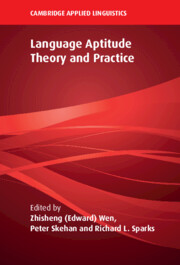Book contents
- Language Aptitude Theory and Practice
- The Cambridge Applied Linguistics Series
- Language Aptitude Theory and Practice
- Copyright page
- Contents
- Figures
- Tables
- Editors and Contributors
- Preface and Acknowledgments
- 1 Language Aptitude Research
- Part I Revisiting and Refining Aptitude Tests
- Part II Aptitude Testing of Diverse Groups
- Part III Innovative Perspectives and Paradigms
- Part IV Aptitude–Treatment Interaction (ATI)
- 14 The Role of Language Aptitude and Timing of Form-Focused Instruction in TBLT
- 15 Implicit (Not Explicit) Learning Aptitude Predicts the Acquisition of Difficult (Not Easy) Structure
- 16 Implicit Statistical Learning and Second Language Outcomes
- Part V Final Commentaries
- Index
- References
15 - Implicit (Not Explicit) Learning Aptitude Predicts the Acquisition of Difficult (Not Easy) Structure
A Visual-World Eye-Tracking Study
from Part IV - Aptitude–Treatment Interaction (ATI)
Published online by Cambridge University Press: 27 May 2023
- Language Aptitude Theory and Practice
- The Cambridge Applied Linguistics Series
- Language Aptitude Theory and Practice
- Copyright page
- Contents
- Figures
- Tables
- Editors and Contributors
- Preface and Acknowledgments
- 1 Language Aptitude Research
- Part I Revisiting and Refining Aptitude Tests
- Part II Aptitude Testing of Diverse Groups
- Part III Innovative Perspectives and Paradigms
- Part IV Aptitude–Treatment Interaction (ATI)
- 14 The Role of Language Aptitude and Timing of Form-Focused Instruction in TBLT
- 15 Implicit (Not Explicit) Learning Aptitude Predicts the Acquisition of Difficult (Not Easy) Structure
- 16 Implicit Statistical Learning and Second Language Outcomes
- Part V Final Commentaries
- Index
- References
Summary
The current study investigated to what extent two aptitude components, one for explicit and the other for implicit learning, could predict the acquisition of English grammatical structures by late L2 English learners in a naturalistic acquisition context. Sixty-five L2 English learners of Chinese Mandarin, as well as a group of English native speakers, performed a visual-world eye-tracking task. This task involved real-time processing of two grammatical properties of the English nominal phrase that differ in terms of L2 psycholinguistic difficulty: (1) definiteness (a difficult structure) and (2) mass–count (an easy structure). Predictors were implicit learning aptitude, measured by the serial-reaction time (SRT) task, and explicit learning aptitude, measured by subtests of the Modern Language Aptitude Test (MLAT Part 4) and the LLAMA_F test. The overall findings suggest that explicit and implicit learning mechanisms are recruited differentially for learning different grammatical properties.
Keywords
- Type
- Chapter
- Information
- Language Aptitude Theory and Practice , pp. 381 - 413Publisher: Cambridge University PressPrint publication year: 2023

